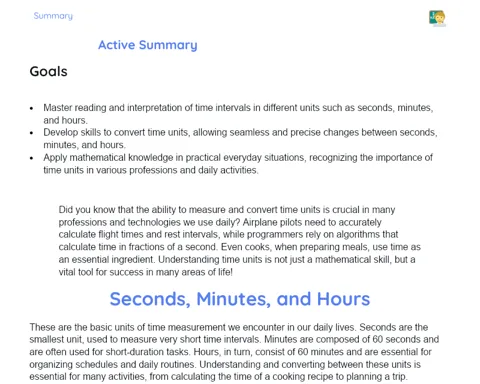Trigonometric Equation | Socioemotional Summary
Objectives
1. Understand the importance of trigonometric functions (sine, cosine, and tangent) in solving equations.
2. Recognize and apply the steps to effectively solve trigonometric equations.
3. Develop the ability to name and manage emotions when facing complex mathematical problems.
Contextualization
Did you know that trigonometry is present in almost every aspect of our daily lives? From bridge engineering to creating special effects in movies, trigonometric equations help us understand and model the world around us. Moreover, learning to solve these equations can help you develop essential life skills such as resilience and self-control! 🚀
Important Topics
Basic Trigonometric Functions
Basic trigonometric functions, sine, cosine, and tangent, are essential for understanding angular relationships and proportions within a right triangle. Let's explore how these functions are defined and their practical applications.
-
Sine (sin): It is the ratio between the length of the opposite side to the angle and the hypotenuse. Example: in a triangle with an angle of 30°, the sine of 30° is 0.5.
-
Cosine (cos): It is the ratio between the length of the adjacent side to the angle and the hypotenuse. Example: in a triangle with an angle of 60°, the cosine of 60° is 0.5.
-
Tangent (tan): It is the ratio between the length of the opposite side and the adjacent side to the angle. Example: in a triangle with an angle of 45°, the tangent of 45° is 1.
Periodicity of Trigonometric Functions
Trigonometric functions are periodic, meaning their values repeat at regular intervals. Understanding periodicity is crucial for solving trigonometric equations, as it helps us identify all possible solutions.
-
Sine and Cosine: Have a period of 2π, which means sin(x) = sin(x + 2kπ) and cos(x) = cos(x + 2kπ), where k is an integer.
-
Tangent: Has a period of π, which means tan(x) = tan(x + kπ).
-
Graphs: Visualizing the graphs of trigonometric functions helps to understand their periodicity and how values repeat over the cycle.
Trigonometric Identities
Trigonometric identities are equations involving trigonometric functions that are true for all values of the angles. They are powerful tools for simplifying and solving trigonometric equations.
-
Fundamental Identity: sin²(x) + cos²(x) = 1. This identity is the foundation of many others and is used to simplify equations.
-
Tangent in Terms of Sine and Cosine: tan(x) = sin(x)/cos(x). This identity helps convert tangents in terms of sines and cosines.
-
Sum and Difference Identities: Provide formulas for sine, cosine, and tangent of the sum and difference of two angles, such as sin(a ± b) = sin(a)cos(b) ± cos(a)sin(b).
Key Terms
-
Trigonometric Equations: Equations involving trigonometric functions such as sine, cosine, and tangent.
-
Sine (sin): Trigonometric function that relates the angle of a right triangle to the ratio of the opposite side and the hypotenuse.
-
Cosine (cos): Trigonometric function that relates the angle of a right triangle to the ratio of the adjacent side and the hypotenuse.
-
Tangent (tan): Trigonometric function that relates the angle of a right triangle to the ratio of the opposite side and the adjacent side.
-
Periodicity: Property of trigonometric functions where their values repeat at regular intervals.
-
Trigonometric Identities: Equations that are true for all values of the angles and involve trigonometric functions.
To Reflect
-
How can you use the identification and naming of your emotions to improve your problem-solving ability, such as with trigonometric equations?
-
Think of a situation outside of mathematics where periodicity (regular repetition) can be applied. How does this relate to the importance of recognizing patterns in your daily life?
-
Consider a moment when you felt frustrated while working in a group. What socio-emotional strategies could you use to improve communication and collaboratively solve the problem?
Important Conclusions
-
Trigonometric functions, sine, cosine, and tangent, are essential for solving equations and understanding the relationship between the angles and sides of a triangle.
-
The periodicity of trigonometric functions is fundamental for finding all possible solutions to equations.
-
Trigonometric identities help simplify and solve complex equations, making them valuable tools in mathematics.
-
Learning to solve trigonometric equations develops socio-emotional skills such as self-awareness, resilience, and effective communication in groups.
Impact on Society
Trigonometric equations have a significant impact on society, from engineering to technology. For example, in civil engineering, trigonometry is used to design and build safe and stable structures, such as bridges and buildings. Additionally, in fields like physics and astronomy, trigonometric equations help model and understand natural phenomena, such as the movement of planets and the propagation of sound waves. This knowledge not only enhances the quality of life but also broadens our understanding of the universe.
In students' daily lives, trigonometry can be present in more subtle ways. Applications such as creating graphics in video games, special effects in movies, and even in financial calculations are part of everyday life. Emotionally, overcoming challenges related to trigonometric equations can enhance students' self-confidence and sense of achievement, strengthening their problem-solving skills and resilience.
Dealing with Emotions
Let's practice the RULER method at home to manage your emotions while studying trigonometric equations. First, recognize your emotions when faced with a problem: are you frustrated, anxious, or excited? Understand the causes of these emotions. For example, frustration may arise from not understanding a concept, while satisfaction may come from solving a difficult problem. Name these emotions correctly. Express your emotions appropriately, perhaps by talking to a peer or writing in a journal. Finally, regulate these emotions by taking time to breathe, relax, and reorganize your thoughts before continuing to study.
Study Tips
-
Practice solving trigonometric equations daily to reinforce your understanding and gain confidence.
-
Use graphs and visual tools to visualize trigonometric functions and their solutions. This helps to better understand periodicity and identities.
-
Form study groups with your peers to discuss and solve problems together, sharing strategies and knowledge.



